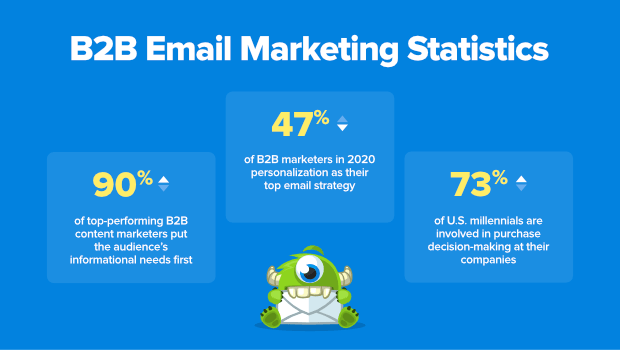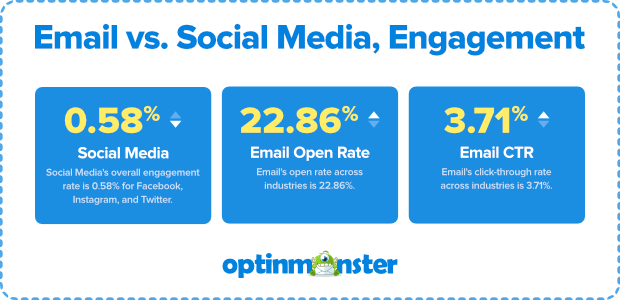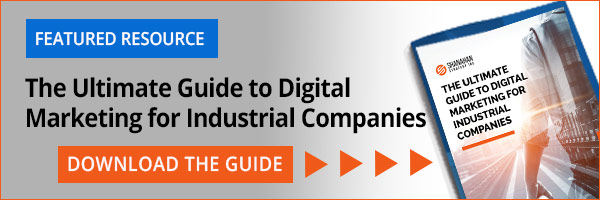Over the past few years, email marketing has gone from being just another rung on your company’s digital marketing strategy ladder to an undeniable necessity. The good news is: 99% of email users check their inbox every day, with some checking 20 times a day. The bad news is: with an increasing number of brands investing in email marketing, it’s harder than ever to capture your contact’s attention and engage them in meaningful conversations.
Executing a successful email marketing campaign is not as easy as it may seem. Anyone who’s tried email marketing knows it’s not as simple as quickly drafting a message and hitting send. After making sure you’re complying with CANSPAM regulations, you have to access the right tools and software, design attractive and engaging emails, create different types of emails for all different situations, and track your metrics.
You might be wondering if email is still a worthwhile marketing strategy. Well, it definitely is. In fact, email generates $42 for every $1 spent, which is an astounding 4,200% ROI, making it one of the most effective marketing tools available.
Today, the key to crafting a successful email marketing strategy lies in creating trust with contacts and building genuine, long-lasting relationships with them. Effective email marketing takes time, effort, listening, analytics, and a strategy.
Ready to learn more about B2B email marketing to generate leads, lets dive in!
Key Takeaways:
- Have a good understanding of your target audience.
- Focus on the needs, concerns, and challenges of your target audience.
- Always provide value and avoid blatant self-promotion.
- Quality content drives engagement. Self-promotion drives unsubscriber loss.
- Be consistent, but don’t overwhelm their inbox with too many emails.
Building Your B2b Email Strategy
The most successful marketing emails are not sent on a whim but are instead part of a larger, calculated strategy. Whether you are launching the first email marketing campaign for your brand or looking to revamp an existing email marketing strategy, the first step is determining your intention. Why are you sending an email? (Tip: it’s not because “everyone is sending emails”— think about why YOU want to send an email and what value it provides to the recipient?)
To determine your email marketing intention, answer this question for yourself: What do you hope to achieve through your email marketing campaign? Your intended goal will determine which type of marketing email you should send and how it will engage your audience.
To help you decide which type of marketing email will best help you achieve your goal, read on for the most common types B2B marketing emails:
Newsletter Email
A newsletter is an email you send regularly to certain segments of your email list that helps you interact and build relationships with your prospects and customers. Typically, these newsletters are summaries of recent content you created and a place for announcements or updates. They are an increasingly popular type of marketing email, but not every brand needs a newsletter.
A newsletter can be beneficial if you’re trying to generate leads and traffic to your website, maintain relationships, better qualify leads, and close more deals.
Informational Email
Similar to a newsletter, this type of email delivers an update to a large group of readers. In these emails, you could send announcements relating to:
- Product/service updates
- New content announcements
- Upcoming events
- Event updates
- Co-marketing partnerships
For example, if you want readers to sign up for your webinar, your informational email should contain facts pertaining to registration windows, times and dates of the event, a short description, and how readers can sign up.
Lead Nurturing Email
Lead nurturing emails are usually part of a connected series that guides prospects further down your sales funnel. They’re launched automatically whenever a user takes a specific action, such as downloading a content offer on a landing page, attending an event or requesting certain information. To maximize your returns with lead nurturing emails, it’s important to segment your audience by behaviors so you’re delivering highly targeted messages to readers at every stage of the buyer’s journey.
Transactional Email
Once you’ve grown your email list a little bit, how do you engage the prospects and customers you have a relationship with? Transactional emails are automatically triggered when a reader performs a specific action, such as signing up for your webinar, registering for a newsletter, purchasing a product, and so on. The most common forms of transactional emails are: confirmation emails, thank you emails and welcome emails.
New Content Announcement Email
When you are ready to announce your next case study, ebook, video, ebook, webinar, or any other promotion, use a new content announcement email to spread the word. The main feature of new content emails is a prominent CTA (call to action). When it comes to designing an email for a specific offer, the main component to keep in mind is the offer itself. You want the copy to be brief but descriptive enough to convey the offer’s value. In addition, include a large CTA underneath the copy to make the action you want email readers to take crystal clear.
Product Update Email
Many companies choose to send weekly or monthly product digests to keep their customers or fan base up-to-date with the latest features and functionalities. These product update emails can be tough to write because their content is typically not as flashy as an offer email. That said, it’s important to keep these emails simple and straightforward.
To keep your email subscribers on their toes, rather than inundating your contacts with a slew of emails about each individual product update, consider sending a sort of roundup of new updates or products periodically.
Event Promotion Email
Don’t overlook email when promoting the upcoming event you’re hosting or attending. If you want to invite your contacts to an event and motivate them to register, it’s extremely important to clearly showcase why that event is worth their time.
Email Segmentation and Lists
Email segmentation is the act of breaking up your large email list into subcategories, or smaller lists, that pertain to your subscribers’ unique characteristics, interests, and preferences. The subscribers to your marketing emails are humans, after all, and we should do our best to treat them as such. That means not sending generic email blasts. Segmentation is a vital part of successful email marketing because if you send the wrong content to the wrong people you run the risk of losing subscribers.
The first step in email list segmentation is creating lead magnets and opt-in forms for each part of the buyer’s journey. That way, your contacts are automatically divided into separate lists depending on what triggered their subscription to your marketing emails. Beyond that, email marketing platforms allow you to segment your email list by contact data and behavior to help you send the right emails to the right people and move leads closer along their journey to becoming a customer and ultimately a brand advocate.
Email Design Tips
Now that you know the best practices on how to send your marketing emails, it is time to consider what you want your emails to look like. The content and design of your marketing emails will be what sets your brand above the competitors in your field. Enticing design and brief, responsive copy are how you effectively keep recipients reading and interacting with your email content. To ensure your emails stand out in subscribers’ crowded inboxes, here are our email design best practices:

Email Subject Line
Considering your email subject line is the first thing anyone sees when you send them an email, its importance cannot be overstated. Your subject line should capture their attention so they want to open the email and continue reading. The best subject lines:
- Grab the attention of your readers in as few words as possible (less is more).
- Provide some sort of value and/ or information that makes them want to open the email.
- Summarize what recipients are going to read and/ or see once they open the email.
Stay on Brand
As soon as your email recipients open your message, they should know the email was sent from your company — meaning your email should be branded to the point that they don’t need to look at who’s sending the message to know it’s from your business.
To maintain your brand voice and appearance through your marketing email, be sure to use a consistent tone through your email content, your social accounts, and your website. Incorporate the same colors and fonts in your email design as you have across all platforms as well. And of course, display your signature logo prominently. With email design, consistency is key. A consistent design and tone will remind your subscriber what they love most about your brand, its uniqueness!
Enhance the User Experience
Subscribers are likely to be turned off by cluttered, unorganized emails. Your email will appear too overwhelming and time-consuming to deal with, and you’ll increase your chances of abandonment. Instead, organize your layout with an eye on user experience (UX).
Leave white space and strategically place your written and visual content in the email so it’s organized and easy to navigate. This will also improve your email’s professional, thoughtful feel, which ensures readers are able to find the information they want and need to enjoy their interactions with your business’s email content.
Additionally, enhancing user experience means using a responsive design. A responsive design means your email changes format to fit the screen it’s being viewed on, whether it’s on a desktop, tablet, or smartphone. Recipients will be able to read your emails with ease no matter where or how they’re viewing them. Responsive design enhances user experience and improves email subscriber retention.
Always Include a Call to Action
Calls-to-action (CTAs) are used to convert your email recipients. They may be used to get your recipients to follow you on social media, visit your website, or become paying customers. CTAs should be visible, enticing, and clearly show why they’re valuable to click.
Remember, as much as CTAs are proven to work, keep an eye on how frequently you are using them. Too many CTAs in one email may overwhelm your subscriber and cancel one another out. Instead, design each email around one or two relevant CTAs with the goal of your email in mind to increase your chances of their interaction.
Email Metrics
To gauge your email marketing efforts, you’ll want to track a few important metrics. Which metrics you measure will depend on your goals. The goal of your company’s email marketing may be very different from the goals of another company, even one like yours. In fact, it may even vary within your own company over time.

Clickthrough Rate
Expressed as a percentage, CTR represents the ratio of people who clicked on one or more of your links to the total number of people who opened your email. CTR gives you immediate insight as to how engaging your content is for your readers.
Conversion Rate
A conversion is recorded anytime a reader takes action after following a link in your email. Similar to your CTR, it’s measured as a percentage. So if the goal of your email is to get readers to sign up for your next webinar, and 200 readers out of 10,000 do actually sign up, then your conversion rate would be 2%.
Bounce Rate
An email bounce happens anytime an email cannot be delivered. These bounces are distinguished as “hard” or “soft”, depending on the circumstances. A hard bounce is due to inactive, closed, or incorrect email addresses. This is a common problem with purchased lists. Hard bounces prevent the email from being delivered in the future and can cause major (and sometimes long-lasting) issues for your brand.
A soft bounce is less serious and not as permanent; it happens when your recipient has a full inbox or their email server is down, for example. When this occurs you have two options: Wait to see if the provider resolves the issue and delivers your message, or resend your message to any addresses marked with a soft bounce.
List Grow Rate
To track the growth of your list, you’ll need to pay attention to the rate at which your email list is growing. Your email marketing database will naturally degrade by 20-25% each year as people switch jobs, abandon old email addresses, and unsubscribe, which makes growing your list and paying attention to this metric even more crucial. Unless you’re refreshing your contacts database with fresh leads every year, your marketing strategy will be based on a dying asset.
Email Forwarding Rate
These important figures represent the percentage of readers who clicked on a “share this” button or a “forward to a friend” link. In both cases, your email recipients are spreading your brand’s message to help you generate new leads. Growth-focused brands and those hoping to create evangelists must improve both of these numbers for success.
Unsubscribe Rate
This is the percentage of email recipients who unsubscribe from your send list after opening a given email. As with open rate, the unsubscribe rate isn’t a reliable picture of the health of your email list. Many subscribers who are tired of receiving email messages from your brand won’t bother to go through the formal unsubscribe process. They’ll just stop opening, reading, and clicking on your email messages.
ROI (Return On Investment)
The ROI for email marketing is no different than what you’re already used to: How many of each type of lead did you generate via email marketing? How does this translate to potential revenue? Actual revenue? These are the types of metrics that will help you show your boss and your sales team how valuable email marketing is as a channel that drives real, tangible results. You should be able to find a direct correlation between your email marketing and your positive sales numbers right there in black and white.
Staying Compliant
CAN-SPAM (Controlling the Assault of Non-Solicited Pornography And Marketing) is an act that gives recipients the right to have a business stop emailing them. Violating this act can result in penalties as high as $15,000 per email. Additionally, in May of 2018, the European Union put the General Data Protection Regulation (GDPR) into effect. This decision was followed shortly by the United States and other countries implementing privacy policies and laws of their own that reflect the regulations outlined in the GDPR requirements.
To avoid being fined for violating either of these:
- Include an unsubscribe link in every single email
- Remove people who have unsubscribed
- Include your physical location in your signature block or footer
- Don’t purchase email lists and send spam emails
- Follow the rules and best practices to avoid being blacklisted
B2B Email Marketing Statistics
- 81% of B2B marketers say their most used form of content marketing is email newsletters. (Content Marketing Institute, 2020)
- 16% of all emails never make it into the inbox. (Email Tool Tester, 2019)
- On average, B2B companies send one email marketing campaign every 25 days. (SuperOffice, 2020)
- 31% of B2B marketers say email newsletters are the best way to nurture leads. (Content Marketing Institute, 2020)
- 87% of B2B marketers say email is one of their top free organic distribution channels. (Content Marketing Institute, 2020)
- 90% of content marketers say email engagement is the top metric they track to measure content performance. (Content Marketing Institute, 2020)
- 89% of all B2B email campaigns are sent from a company name. (SuperOffice, 2020)
- The second-most common technology B2B organizations use to assist with content marketing is email marketing software. Roughly 85% of marketers say they work with these tools. (Content Marketing Institute, 2020)
Mobile Marketing Statistics
- Nearly 55% of global website traffic is generated from mobile devices, excluding tablets. (Statista, 2021)
- Apple iPhone’s native email app has the highest market share, followed by Gmail. (Litmus Labs, 2021)
- Nearly 1 in 5 email campaigns is not optimized for mobile devices. (SuperOffice, 2020)
- Launching a mobile-responsive email design can increase unique mobile clicks by 15%. (MailChimp, 2019)
- Mobile-friendly email is the second most-used tactic email marketers to improve their performance. (HubSpot, 2020)
- 9.3% of email clicks come from tablets, rather than smartphones or computers. (MailChimp, 2019)
- Although people primarily check email on iPhone devices, Gmail is still the most-used email service, with more than 1.5 billion users. (CNBC, 2019)
Ultimately, email, like most channels and strategies, is about delivering the right message at the right time to the right person. By taking the time to do the planning and preparation, you can boost your open and click-through rates to generate new leads and business for your company.

